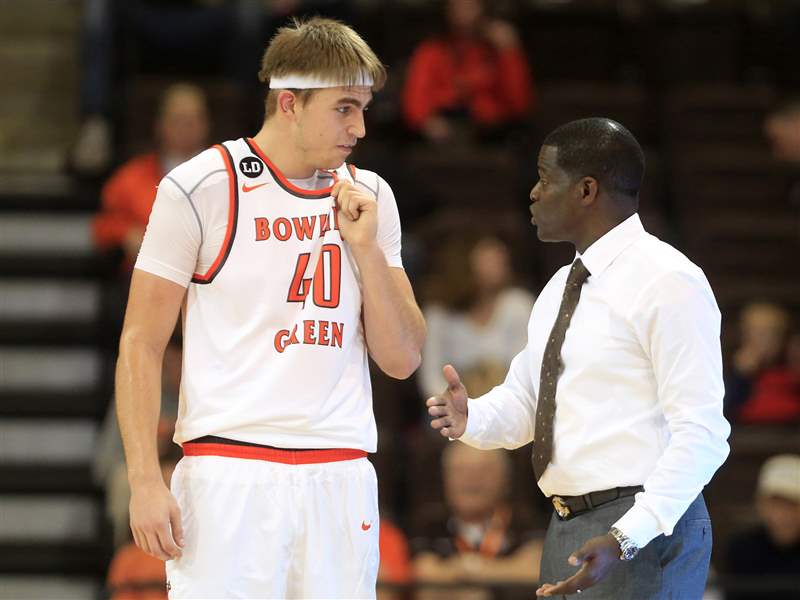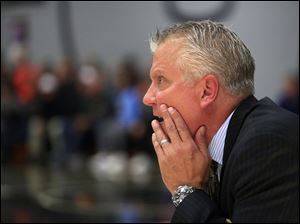
The toughest job in college hoops? Making a schedule
12/26/2017
Bowling Green coach Michael Huger said the hardest job in college basketball is scheduling. Trying to get any sort of balance in a schedule can be a tall challenge.
Blade/Kurt Steiss
Some college basketball fans think the toughest job in the sport is coaching the team, helping players improve in practices and in games.
Other fans might think the toughest job is recruiting, especially when Mid-American Conference coaches attempt to convince top-flight athletes to join their programs rather than playing for major-conference schools.
Bowling Green State University men’s basketball coach Michael Huger disagrees.
“Outside of basketball operations, I think scheduling is the hardest job in college basketball,” Huger said.
That’s because MAC coaches have the unenviable task of filling a nonconference schedule with balance. That includes a balance of games at home and on the road, as well as games against top-flight teams that should result in confidence-building wins, and games that don’t break the bank financially with some that cost a little more.
When it comes to home games, fans wishing for Toledo to host Indiana, as it did when the school christened a new arena then called Centennial Hall in 1976, or for Bowling Green to host Michigan State, as it did in 2012, are wishing for something that has little chance of happening.
“The only way you’ll get a power-conference school to play at your home is to have a relationship with the opponent, and you’re lucky if you can find that,” Huger said. “Now, that’s rare [if] you can find a power-conference school that will do that.
“They don’t need our money. If we offered, say, $150,000, to a big-time school as a guarantee, they would laugh at us.”
University of Toledo coach Tod Kowalczyk said that holds true for the next tier of potential opponents from such conferences as the Missouri Valley, American, Atlantic 10, and Big East.
“If you’re one of the top programs in the Mid-American Conference, you’re not going to get any ‘bad’ power-conference teams to play you home-and-home,” he said. “And you’re certainly not going to get any high-major teams to play you home-and-home.
“We’ve begged Dayton and Xavier to play us, and we’ve begged Michigan to play us two-for-one. [Michigan coach] John Beilein said in front of our Rocket Roundball social that he would never, ever play in Toledo — and he said that in respect to our program.
“We’re dying to play teams like Xavier, or Dayton, or Cincinnati. But getting them to come up here? They won’t do it.”
So the MAC looks to similar-sized schools in similar leagues, such as the Horizon League — and those two leagues meet 19 times in the nonconference season. But what other options are there?
While the Summit League, for example, includes Fort Wayne in Indiana, it also has schools in Oklahoma, Colorado, North Dakota, and South Dakota.
“The Horizon League is close, and they’re in the same boat we are,” Huger said. “The Summit League is good, but it’s so spread out. Do you want to go to Denver or South Dakota to play games?”
RELATED: What does playing MAC schools mean for lower-division schools such as Lourdes?
Some schools do not even try to schedule home games. An extreme example is Texas Southern, which played Dec. 2 at Toledo. The Tigers played all of their 13 nonconference games on the road — and faced a virtual who’s who of the college basketball world by playing at Gonzaga, Syracuse, Kansas, Oregon, and Baylor, among others.
It’s no wonder Texas Southern will carry an 0-13 record into Southwest Athletic Conference play.

Toledo's head coach Tod Kowalczyk said his program has "begged" Dayton and Xavier to play the Rockets, and even offered a "two-for-one" proposal to Michigan, all with no results.
“Texas Southern’s basketball program has been good under [former Indiana coach] Mike Davis — and they have to support the entire athletic department [financially] through guaranteed money,” Kowalczyk explained. “I didn’t ask, but I’ll bet they’re bringing in $1.5 million or more in guarantees to fund the other sports at that school.
“I think his administration is supportive in that they don’t care if he wins the nonconference games; they want to make money in their nonconference games. They only care about winning their league, which he has done [three of the last four seasons].”
That also points to a problem mid-majors have in scheduling road games against lesser teams in power conferences: Facing teams with lower RPI rankings can hurt the resume of a team looking to make the NCAA tournament.
“BCS and Power Five schools are willing to pay money to schools like Texas Southern because they know it will be a good RPI game,” Kowalczyk said. “At the end of the season, a bubble team playing Texas Southern is happy because they want to schedule the top 150 teams, RPI-wise, which makes Texas Southern a good ‘buy’ game.
“They don’t want to play a team that’s going to have an RPI around 350, because that looks bad to the NCAA selection committee.”
Huger agreed, adding, “There’s not a big difference between their league and ours, so they’re afraid we might mess around and beat them. And they don’t want that, so they have to schedule cautiously. They’re selective about what teams they play and when they play them.”
But sometimes scheduling is difficult because there are so many moving parts in the process.
“Dates have to match up — and you have to figure out if it’s a home-and-home or a guaranteed game,” Huger said. “And if it’s a guaranteed game, how much money will you get?
“We’re already looking at scheduling games three years from now. It’s so difficult, because everything has to match up so you don’t play games too close together or too far apart when you do find an opponent.
“And you have to work out dates and times with your facilities. You’re scheduling for men’s and women’s basketball, and there are other events as well.”
At Toledo, Kowalczyk said his goal is to try to schedule as many home games against good mid-major teams as possible.
“Marshall is a good mid-major team, St. Joseph’s is a good team, and Oakland is a good team,” he said, referencing teams UT played this year. “Detroit is a talented team, and Wright State is going to win some games in their league.
“Those games make sense because they’re regional — you don’t have to get onto an airplane, so that saves budget money. I would like to play the local Horizon League schools every year; it just makes sense.
“I would rather play them than traveling to Georgia Southern for a home-and-home. It’s about name recognition, and it saves us a lot of money.”
Huger said he also tries to schedule nonconference games that will help his team prepare for what it will see during the conference season.
“South Carolina-Upstate plays zone [defense], and we’ll see that again when we play Eastern Michigan,” he said. “We played teams that use different kinds of pressure man-to-man, because we’ll see that against Buffalo.
“That’s not always easy to do, but that’s what we look for.”
Scheduling for a MAC program is a far cry from the same job for Big Ten schools like Ohio State, which will play nine of 13 nonconference games at home — and the other four were played at a neutral site — and Michigan, which had just one true road game on its out-of-league slate.
“That’s why I think that if you win 20 games at our level, it’s like winning 25 in the Big Ten,” Kowalczyk said.
Contact John Wagner at: jwagner@theblade.com, 419-724-6481, or on Twitter @jwagnerblade.